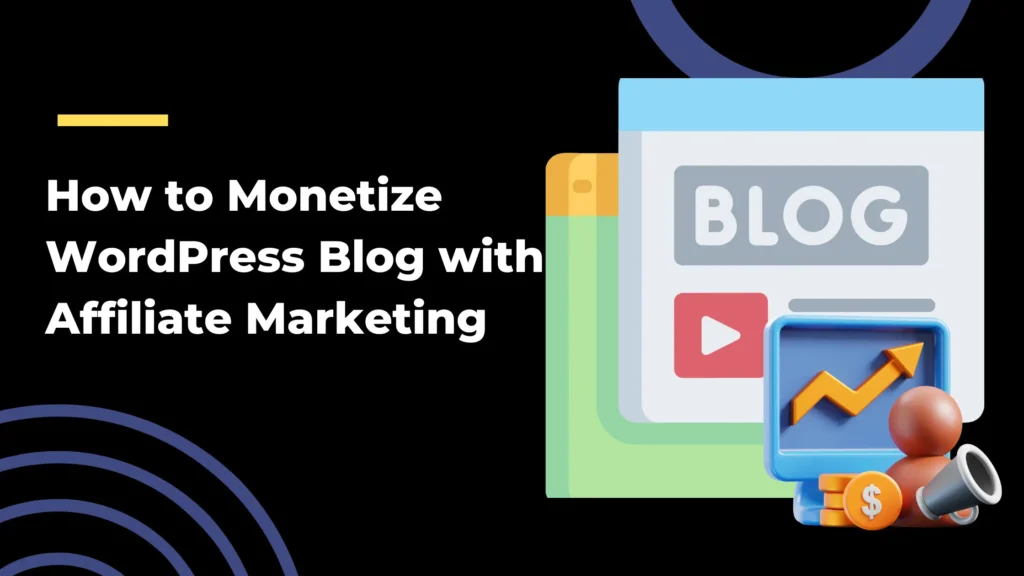Monetize WordPress Blog with Affiliate Marketing: Affiliate marketing has become one of the best ways for bloggers to earn income online. Whether you’re just starting out with a WordPress blog or looking to increase your income, affiliate marketing can be a game-changer. In this comprehensive guide, we’ll dive deep into what affiliate marketing is, why it’s a great idea, and how you can effectively use it on your WordPress blog to generate the same income.
Table of Contents
ToggleWhat Is Affiliate Marketing?
Affiliate marketing is a business-based business where businesses pay individuals or websites (affiliates) to increase sales or leads through advertising content words. As a blogger, you can become a member by promoting products or services through special links provided by the company. When someone clicks on your link and makes a purchase, you usually get a cut of the sale, usually between 5% and 50%, depending on the product or service. So, once you place affiliate links in your content, you can continue to make money while you sleep. All it takes is consistent traffic and good content planning.
Why Affiliate Marketing is Perfect for WordPress Bloggers
For WordPress bloggers wishing to make money off of their content, affiliate marketing has the following benefits:
- Minimal startup costs: You do not have to produce or market any tangible goods. All you have to do is advertise the goods of other companies, and you will be paid for each sale.
- Passive income: If you concentrate on evergreen content, affiliate links have the potential to continue making money long after the material is released.
- Flexibility: You can select affiliate items based on the industry, technology, fashion, fitness, travel, or any other area that corresponds with the specialisation of your blog.
- High scalability: greater hits and possible sales through your affiliate links translate into greater income the more traffic your site receives.

7 Steps to Monetize WordPress Blog with Affiliate Marketing
1. Choose a Profitable Niche
The first step to creating a successful affiliate market is choosing a niche for your blog. Your niche should not only match your interests, but there should also be a market for the product or service. If you are passionate about what you write about, it will resonate with your audience and result in better engagement and more sales. When you embed your links in your content, you can continue to make money while you sleep. All it takes is consistent traffic and good content planning.
Here are a few lucrative niches with lots of affiliate opportunities:
- Technology and gadgets: There are lots of affiliate programmes available if you enjoy reviewing tech products, devices, or software.
- Promote fitness gear, dietary supplements, or holistic wellness items in the context of health and wellness.
- Personal finance: Provide investing platforms, credit card recommendations, and money management guides.
- Beauty and fashion: There are many and well-liked affiliate programmes related to skincare, makeup, and clothing.
- Online education and courses: Highlight websites that provide online classes across a range of subjects, such as Coursera and Udemy.
2. Sign Up for Affiliate Programs That Fit Your Niche
The next step after deciding on your niche is to join affiliate programmes that complement the subject matter of your blog. There are many affiliate programmes available, and it is usually easy to sign up. Here are some well-known affiliate programmes for bloggers:
- Amazon Associates: One of the biggest affiliate programmes, Amazon Associates lets you promote millions of products in almost any niche. Commissions range from 1% to 10%.
- ShareASale: ShareASale offers a wide range of products across different industries and partners with a variety of merchants.
- CJ Affiliate (formerly Commission Junction): CJ Affiliate is another big affiliate network that has partnerships with major brands like Expedia, Overstock, and GoPro.
- ClickBank: ClickBank is a company that specialises in digital products like eBooks, software, and online courses.
- Impact: Impact offers a wide range of affiliate marketing partners, including prestigious IT, finance, and other brands.
Examine the commission rates, payment periods, and cookie lengths (the amount of time a sale is credited after clicking your link) for each programme before registering. Recurring commissions are something that certain programmes offer, and they can be quite profitable if you are marketing subscription-based services.
3. Create High-Quality Content That Engages Your Audience
The most important factor in successful marketing is the quality of your content. Your blog should provide real value to your readers, whether through detailed product information, how-to information, or comparisons. Good, helpful content will engage your readers and build trust, making them more likely to click on your links.
To assist you with smoothly integrating affiliate links, consider the following content ideas:
- Product Reviews: Provide frank and thorough evaluations of goods or services you have tried. To gain the readers’ trust, emphasise both the advantages and disadvantages.
- How-to Manuals: Make thorough instructions that walk users through using a product or resolving an issue. Provide affiliate links for the products or tools you advocate.
- Create curated lists of the top goods in your niche, such as “Best Budget-Friendly Fitness Gear for 2024” or “Top 10 Must-Have Travel Accessories.”
- Comparative Articles: Compose comparison articles that assess two or more comparable goods. For instance, you might contrast several software programmes or hosting companies.
4. Strategically Place Your Affiliate Links
When adding links to your WordPress blog, it’s important to get it right. The goal is to make the link look natural and useful, rather than trying to aggressively sell products. Readers are more likely to click on a link that appears in the context of your content.
Here’s how to properly place affiliate links:
- In-text links: To keep your material flowing naturally, insert affiliate links within pertinent lines. For instance, link your affiliate link to the product name in a product review.
- Call forCTAs, or action buttons: To entice readers to click, use CTA buttons that are obvious and appealing, such “Buy Now” or “Check Latest Price.”
- Banner Ads: You can show banner ads from a number of affiliate programmes on your website. For optimal visibility, place these in the text, footer, or sidebar.
- Product comparison tables should be made, and each product’s affiliate link should be included. Tables give readers an easy-to-understand visual representation that makes comparing characteristics simple.
5. Optimize Your WordPress Blog for Conversions
While increasing blog traffic is crucial, the ultimate objective is to turn those visitors into customers. Improve the conversion rate of your blog to optimise your affiliate income. Here’s how to carry that out:
- Boost Page Load Speed: Websites that load more quickly offer a better user experience and rank higher in search results. To speed up load times, use caching plugins like WP Rocket or W3 Total Cache.
- Mobile responsiveness: Your blog must look fantastic and work flawlessly on smartphones and tablets as more people browse the internet on these devices.
- Appealing CTAs: Try varying the text and button on your CTAs to see what gets more clicks and conversions.
- Exit-Intent Popups: To attract visitors who are ready to depart, use exit-intent popups.
6. Track Your Performance and Refine Your Strategy
Monitoring your progress is crucial to enhancing your affiliate marketing endeavours. With the built-in analytics that most affiliate programmes offer, you can keep an eye on click-through rates (CTR), conversions, and revenues. Examine which material generates the most clicks and revenue, then adjust your approach appropriately.
- Google Analytics: To find out which pages or posts are generating the most affiliate revenue, set up conversion tracking using Google Analytics.
- A/B testing: To maximise conversions, test out various designs, call-to-actions, and link locations.
- Affiliate Program Measures: Examine the performance indicators offered by your affiliate programme dashboard to determine what is successful and what requires development.
7. Drive Targeted Traffic to Your Blog
You need steady traffic if you want to make affiliate sales. Your possibilities of making money with affiliate links increase with the amount of people that view your content. The following are some methods to increase targeted traffic to your blog:
- Make sure your material is optimised for search engines by using alt text for photos, making SEO-friendly URLs, and focussing on relevant keywords.
- Social media marketing: Use sites like Facebook, Instagram, Pinterest, and Twitter to spread the word about your blog entries. For the most engagement on each platform, customise your strategy.
- Email marketing: Create a list of subscribers and market affiliate products to them. When done properly, email marketing can result in a large increase in visitors and sales.
- Guest posting: You can obtain backlinks by creating guest posts on reputable blogs within your industry.
Conclusion: Monetize WordPress Blog with Affiliate Marketing
Using affiliate marketing to monetise your WordPress blog is a great method to generate passive money. You can make consistent income by picking the appropriate niche, producing excellent content, and positioning affiliate links thoughtfully. To raise your affiliate revenue over time, keep improving your strategy, making your blog more optimised, and bringing in more relevant traffic.
If you put in the effort and have patience, affiliate marketing may be a very effective way to increase the revenue from your site.
References:
Checkout new Blogs:
- Top OnPage SEO Tools to Boost Your Website Ranking
- Top Free SEO Tools for Website Optimization
- Top 5 Lightweight WordPress Themes for Faster Website Load Time
- Local SEO for E-commerce: A Guide to Driving Targeted Traffic
- How to Secure WordPress Site with Free Tools and Plugins
- How to Easily Build a Membership Site in WordPress: A Step-by-Step Guide
- WordPress Site on Web 3.0: The Ultimate Guide to Getting Started



